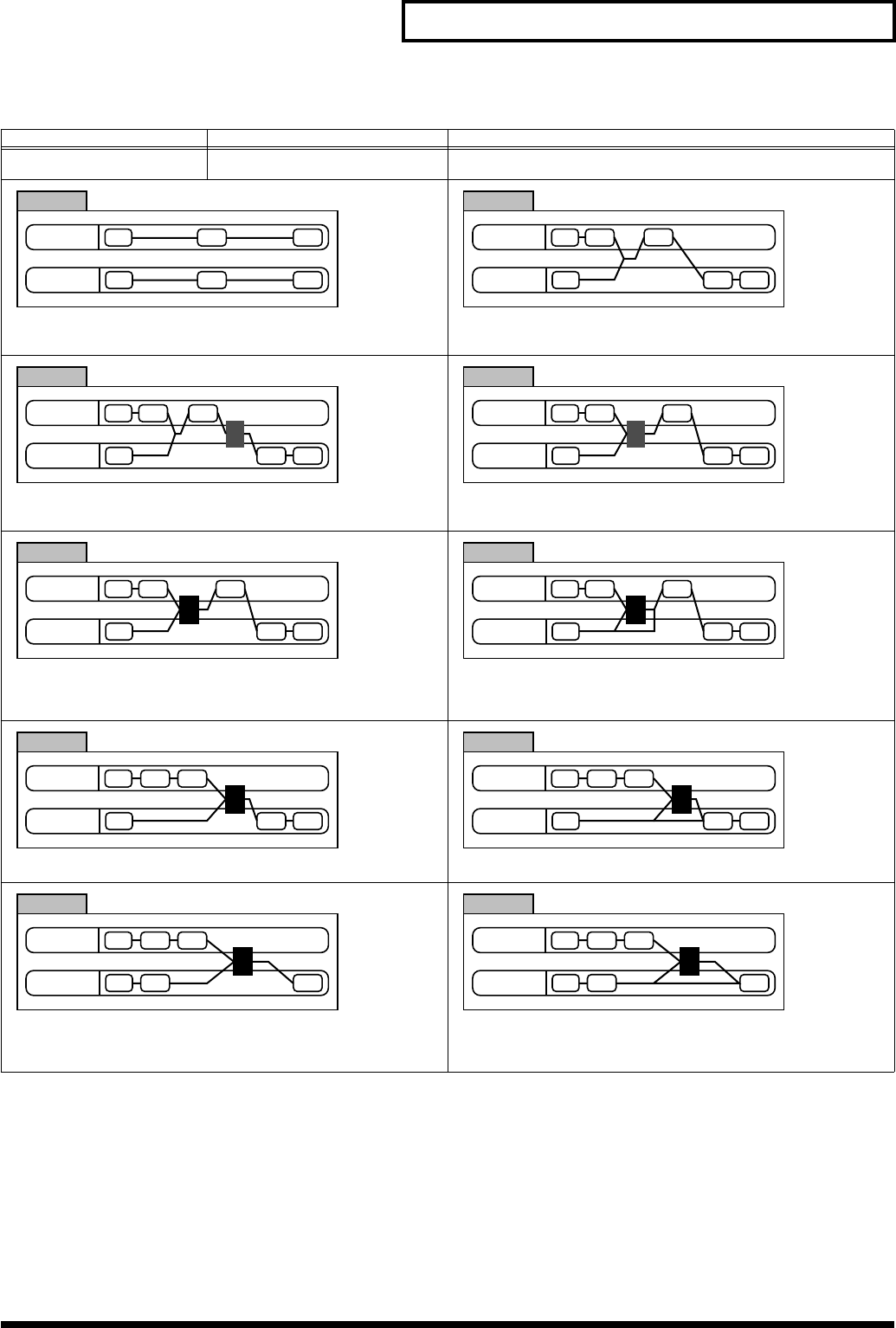
35
Creating a Patch
Changing How a Tone Is Sounded (Structure)
* When TYPE 2–10 is selected and one tone of a pair is turned off, the other tone will be sounded as TYPE 1 regardless of the displayed setting.
* If you limit the keyboard area in which a tone will sound (Keyboard Range, p. 37) or limit the range of velocities for which it will sound (Velocity Range, p.
38), the result in areas or ranges where the tone does not sound is just as if the tone had been turned off. This means that if TYPE 2–10 is selected and you
create a keyboard area or velocity range in which one tone of a pair does not sound, notes played in that area or range will be sounded by the other tone as
TYPE 1 regardless of the displayed setting.
Parameter
Value Explanation
Struct 1 & 2, 3 & 4
(Structure Type)
TYPE 01–TYPE 10 Determines how tone 1 and 2, or tone 3 and 4 are connected.
The following 10 different Types of combination are available.
With this type, tones 1 and 2 (or 3 and 4) are independent. Use this type when
you want to preserve PCM sounds or create and combine sounds for each tone.
This type stacks the two filters together to intensify the characteristics of the fil-
ters. The TVA for tone 1 (or 3) controls the volume balance between the two
tones.
This type mixes the sound of tone 1 (3) and tone 2 (4), applies a filter, and then
applies a booster to distort the waveform.
This type applies a booster to distort the waveform, and then combines the two
filters. The TVA for tone 1 (or 3) controls the volume balance between the two
tones and adjusts booster level.
This type uses a ring modulator to create new overtones, and combines the two
filters. The tone 1 (3) TVA will control the volume balance of the two tones, ad-
justing the depth of ring modulator.
This type uses a ring modulator to create new overtones, and in addition mixes
in the sound of tone 2 (4) and stacks the two filters. Since the ring-modulated
sound can be mixed with tone 2 (4), tone 1 (3) TVA can adjust the amount of the
ring-modulated sound.
This type applies a filter to tone 1 (3) and ring-modulates it with tone 2 (4) to cre-
ate new overtones.
This type sends the filtered tone 1 (3) and tone 2 (4) through a ring modulator,
and then mixes in the sound of tone 2 (4) and applies a filter to the result.
This type passes the filtered sound of each tone through a ring modulator to cre-
ate new overtones. The tone 1 (3) TVA will control the volume balance of the two
tones, adjusting the depth of ring modulator.
This type passes the filtered sound of each tone through a ring modulator to cre-
ate new overtones, and also mixes in the sound of tone 2 (4). Since the ring-mod-
ulated sound can be mixed with tone 2 (4), tone 1 (3) TVA can adjust the amount
of the ring-modulated sound.
TONE 1 (3)
TONE 2 (4)
TVATVF
WG
WG
TVF TVA
TYPE 1
TONE 1 (3)
TONE 2 (4)
TVA
TVF
WG
WG
TVF TVA
TYPE 2
TONE 1 (3)
TONE 2 (4)
TVA TVF
WG
WG
TVF TVA
B
TYPE 3
TONE 1 (3)
TONE 2 (4)
TVA TVF
WG
WG
TVF TVA
B
TYPE 4
TONE 1 (3)
TONE 2 (4)
TVA TVF
WG
WG
TVF TVA
R
TYPE 5
TONE 1 (3)
TONE 2 (4)
TVA TVF
WG
WG
TVF TVA
R
TYPE 6
TONE 1 (3)
TONE 2 (4)
TVATVF
WG
WG
TVF TVA
R
TYPE 7
TONE 1 (3)
TONE 2 (4)
TVATVF
WG
WG
TVF TVA
R
TYPE 8
TONE 1 (3)
TONE 2 (4)
TVATVF
WG
WG
TVF TVA
R
TYPE 9
TONE 1 (3)
TONE 2 (4)
TVATVF
WG
WG
TVF TVA
R
TYPE 10
JUNO-G_e.book 35 ページ 2006年2月13日 月曜日 午後2時44分


















